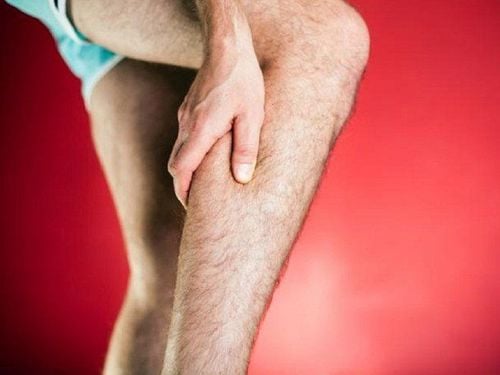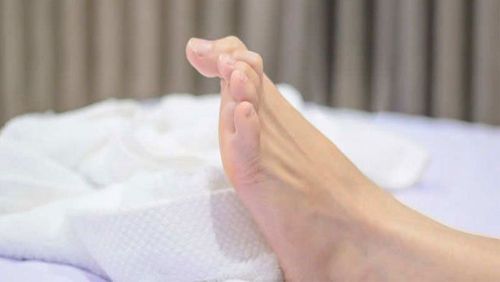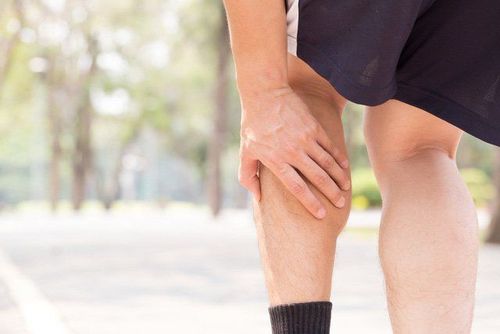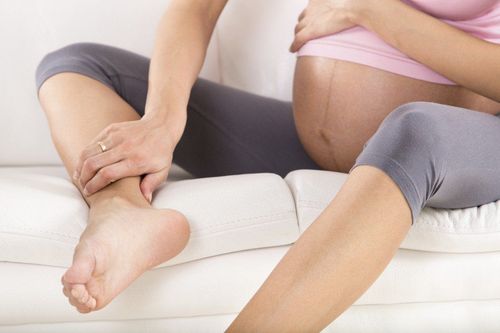This is an automatically translated article.
Cramps is a disease that can occur at any age but tends to increase with increasing age and affects the sleep of the elderly. Usually cramps do not last long and are not dangerous, but if the cramps occur while driving, operating machinery, swimming in water, etc., they can cause an accident or drowning.
1. General information about cramp?
A cramp is a strong, painful contraction and tightening of the muscles, usually coming on suddenly and lasting from a few seconds to a few minutes, making the patient unable to continue moving. Patients often have cramps in the hands, thighs, feet, back, buttocks and cramps of the intercostal muscles, abdominal muscles. Cramps are very dangerous if you are swimming in water, sitting near a fire or while driving. The disease usually appears mainly in the legs at night.
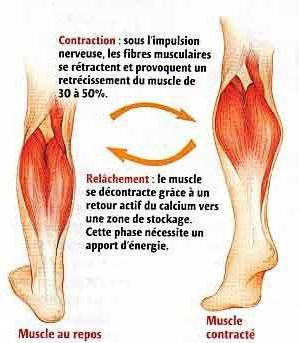
Chuột rút là cơn co mạnh, đau và thắt chặt các cơ
The disease can occur at any age but tends to increase with increasing age and affects the sleep of the elderly. According to statistics, about a third of people over 60 years old and half of all people aged 80 years and older often experience cramps, especially at night.
In young people, sometimes cramps are also experienced. People who have cramps 3 times a week account for 4/10, even some people have cramps every day. If the cramps recur many times or are accompanied by other symptoms such as drinking a lot of urine, fatigue, fear of cold, weight gain, pale, pale skin, leg pain when walking short distances... an illness that needs to be examined.
Usually, each time a cramp occurs, it usually lasts from a few seconds to a few minutes, but in some cases it lasts more than 10 minutes.
2. Dealing with cramps
When you are exercising and suddenly have a cramp, it will be very painful in the muscles, causing you to stop immediately and not be able to move anymore. To get rid of pain quickly, you need to do the following actions:
When you have a cramp in any part of your body, the first thing you need to do is stop moving immediately. When you have hand cramps (rare but can happen in people who have to use their hands with repetitive movements for a long time), try to relax the cramped limb to relax the muscles. is shrinking. Gently pull the cramp fingers, if the oil is hot, apply the oil to the skin of the muscle that is contracting and massage gently. If your leg cramps, gently straighten your leg and bend your foot toward the knee, squeezing one hand firmly into your heel. At the beginning of application, the pain may increase, but soon the pain will decrease because the muscles stop spasms and blood circulation is restored. When the cramps are gone, gently massage the muscle that has just been spastic to allow blood to circulate again to avoid recurring cramps.
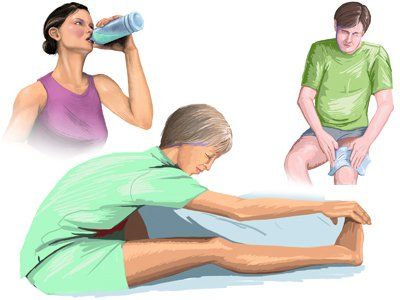
Nếu chuột rút chân, bạn nên nhẹ nhàng duỗi thẳng chân ra và gập bàn chân về phía đầu gối, ép mạnh một tay vào gót chân
When you have a thigh cramp, you should ask someone to straighten the leg, raise the heel with one hand, and press the knee with the other hand at the same time. In case of intercostal muscle cramps, you must take deep breaths to relax the diaphragm while gently massaging the muscles around the ribcage and drink some hot sugar tea, oresol, orange or lemon juice.. When you have cramps in your back or you have cramps in your buttocks, adjusting your sitting position can greatly reduce pain. However, in such cases, it is important to have short periods of rest and movement to relieve excessive muscle tension. Take a warm bath to relax your muscles. Placing a heating pad on the muscle can also help relax the muscle or using an ice pack. Always keep a cloth between the skin and the pack; Medication is usually only needed in cases of persistent cramps that don't improve after exercise. If you have secondary leg cramps, treating the underlying cause can help relieve symptoms. If you only get a cramp once in a while, it's usually not a big deal. But if you have frequent cramps, discomfort, leg swelling, redness or change in skin color, muscle weakness, and the condition doesn't usually improve with self-care methods, then go for it. See a specialist to get tested and get the right diagnosis and treatment of the disease causing the cramps.
3. Methods to prevent cramps
You can completely prevent cramps by:
Drink enough water, about 1.5 - 2 liters, preferably mineral-rich water such as: oresol water, salted sugar lemonade, coconut water. .. before, during and after exercising, working out, walking or climbing. Warm up before your workout to warm up and stretch your muscles. A minimum of 10 minutes is required. After exercise, you should also do stretching exercises to relax the muscles. Can use some drugs to treat cramps such as vitamin E, muscle relaxants... Therapy and massage of the muscles. Should eat a lot of vegetables in the main meals, after each meal should add fruits such as bananas, apricots, dates, grapes, oranges, papayas, mangoes, durians, pomegranates, pears.

Nên ăn nhiều rau trong các bữa ăn chính và khởi động trước khi tập luyện để làm ấm và kéo căng cơ bắp
When sitting, bend your feet towards the knees as high as possible, so that the blood can easily circulate in the calf muscles. Follow a balanced diet with enough nutrients: protein, sugar, fat, vitamins and minerals. Limit drinking alcohol and coffee because it has a diuretic effect that makes the body lose a lot of water. Do not bathe in too cold water, especially in the sea or in cold water swimming pools. When working hard, sweating a lot, it is necessary to add water with salt mixed (it is best to add oresol solution). Before going to bed, stretch and gently massage your legs, do not exercise too hard. Normally, try not to let your legs stay in a fixed position or maintain bad posture for too long. Avoid stress, excessive stress, because it can lead to cramps, it can make hormones in the body out of balance, rapid heart rate, high blood pressure. Regular health check every 6 months. Vinmec International General Hospital provides customers with a general health check-up package to help them periodically check and detect disease-causing risks in order to screen and maintain a healthy life.
Customers can directly go to Vinmec Health system nationwide to visit or contact the hotline here for support.
SEE ALSO :
Frequent cramps, is it worth worrying about? Causes of cramps during pregnancy How to treat and prevent cramps during pregnancy





